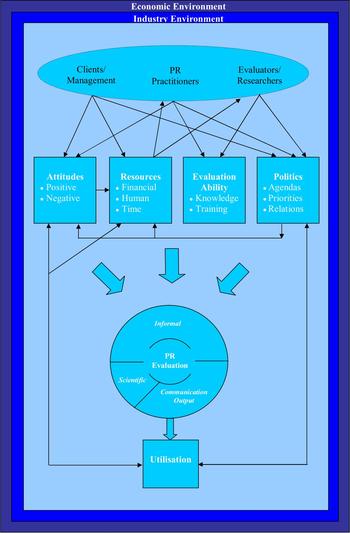Studie zur Praxis der PR-Evaluation und Einflussfaktoren auf diese in Irland
Eine aktuelle Studie aus Irland zeigt einmal mehr, dass PR-Evaluation in der Praxis nicht nur vom How-to-Do-Wissen abhängt, sondern dass vielmehr auch Faktoren wie Einstellungen, Ressourcen, organisationspolitische Entscheidungen und Instrumentalisierung der Ergebnisse eine wichtige Rolle spielen. Wir haben mit der verantwortlichen Wissenschaftlerin, Dr. Mairead McCoy von der University of Ulster in Nordirland, über die Studie und deren Ergebnisse gesprochen. Lesen Sie hier das Interview mit ihr (in Englisch):
communicationcontrolling.de: Ms McCoy, could you please explain in short your current research project on contextual influences on PR evaluation practice and name a few central findings?
Mairead McCoy: This research project, carried out with my colleague Professor Owen Hargie, was underpinned by two principal themes from previous research. Firstly, there has been a recurring discrepancy between practitioners’ professed importance of PR evaluation and actual performance of evaluation. Secondly, with some notable exceptions, previous studies which span over a 25-year period demonstrate little in the way of substantial improvement in regards to the widespread execution of systematic and formal evaluation approaches. Furthermore, the majority of attention has focused almost exclusively on examinations of ‘what’ PR practitioners do or clinical prescriptions of ‘how to’ evaluate PR. The question of ‘why’ practitioners do what they do in terms of evaluation has been largely overlooked. It was felt that understanding why such behaviour occurs in practice would be an important step towards making progress in this area. The aim of the study was therefore to investigate current practice of PR evaluation on the island of Ireland and subsequently explore the issues surrounding the adoption and implementation of evaluation systems in the PR context. To this end a mixed method research design was employed consisting of postal questionnaires distributed to members of PR professional associations and a series of qualitative depth interviews with evaluators and PR decision makers.
Key findings include:
- 80% of the PR professionals surveyed carried out some form of PR evaluation.
- Few methodologies were frequently used to evaluate PR. Only informal techniques such as judgement and intuition and the measurement of media coverage and content analysis were conducted on a regular basis.
- Three styles of PR evaluation activity were identified as scientific; informal and communication output evaluation. The informal evaluation style was the most commonly used form of PR evaluation, while the scientific style was conducted infrequently.
- Of those who did evaluate, the majority (67.4%) allocated less than 5% of the PR budget to evaluation.
- 43.2% of the PR practitioners surveyed handled their PR evaluation entirely by themselves with less than one fifth (19.7%) of PR evaluation activity undertaken solely by dedicated research personnel.
- The major constraints to PR evaluation were identified as:
- a lack of resources – financial, time and personnel
- lack of evaluation expertise
- problems with evaluation methodologies
- lack of interest from management/clients
- evaluation ‘politics’
- Reasons for conducting evaluation included:
- defending PR
- learning from past performance
- accountability
- credibility
In short, findings indicate that knowledge of how to evaluate is only one input into the complex analysis of PR evaluation practice that also includes an interaction with factors such as attitudes, resources, ‘politics’ and utilisation of results. The wider industry and economic contexts are also important.
communicationcontrolling.de: Based on these findings you developed a “Contextualised Model of PR Evaluation”. What exactly does it describe and in which way does it help practitioners wishing to implement or modify PR evaluation?
Mairead McCoy: It is important to point out that the model is not a guide for practitioners in terms of ‘how to’ evaluate PR. Rather it highlights the wider context of evaluation so that practitioners who wish to implement or modify PR evaluation systems can use the model to identify the factors that may inhibit or promote the process and thus help to develop effective strategies to address them.
The Contextualised Model of PR Evaluation illustrates the main actors and the various dynamic influences on PR evaluation practice. In the first instance, the model depicts the people potentially involved in the PR evaluation process i.e. PR practitioners, their client/manager and evaluators/researchers (although it is recognised that each of the three personnel may not be represented in all cases). It was found that the source of evaluation research affected PR evaluation behaviour and attitudes. For example, respondents who availed of research expertise made more frequent use of the scientific PR evaluation style.

The Contextualised Model of PR Evaluation
Four mediating factors are shown to be associated with PR evaluation practice. These are attitudes, resources, evaluation ability and ‘politics.’ The relationship between each variable is important. For instance, the model illustrates that clients/management influence PR evaluation by their attitudes, the resources they allocate to the task as well as by their potential involvement in evaluation ‘politics.’ The attitudes and evaluation ability of PR practitioners and evaluators/researchers affects evaluation behaviour as does their possible association with political issues. It is also suggested that resources affect whether evaluation is allocated to PR practitioners themselves or to evaluation/research personnel. Moreover, political issues can also influence resource allocation as well as attitudes. Similarly, attitudes towards evaluation may affect the resources that are allotted to the task.
The next section of the model depicts the styles of informal, communication output and scientific evaluation identified from the current research. These are often carried out simultaneously and as different organisations may conduct varying amounts of each style, the size of each segment can be adjusted accordingly. In the next stage of the model, the information gathered from PR evaluation is put to use. Utilisation of evaluation information can both affect, and be affected by, evaluation politics. Moreover, the way in which evaluation is used can influence attitudes (of clients and practitioners) which can in turn circuit the process so that attitude, resource, evaluation skill and political variables are subject to alteration and change. The relations described in the inner diagram take place within the wider contexts of industry and economic environments.
communicationcontrolling.de: What would you say are the key differences in your contextualised model to existing models of PR evaluation?
Mairead McCoy: Existing models of PR evaluation provide a useful framework from which practitioners can define and implement PR evaluation strategies, but their focus is almost exclusively on a clinical prescription of ‘how to’ evaluate PR. In contrast, as illustrated in the Contextualised Model, knowledge of how to evaluate (evaluation ability) is only one input into the complex analysis of PR evaluation practice that also includes an interaction of individual, managerial, organisational and environment factors. Of course practitioners must be aware of, and knowledgeable about, evaluation methods in order to carry out evaluation. However other factors can hinder implementation of evaluation. For example, if adequate budget is not invested in evaluation, if managers/client do not ask for evaluation, or if practitioners are wary of how results will be used. The Contextualised Model offers a framework for a more holistic understanding of the factors that influence evaluation behaviour.
communicationcontrolling.de: Which general conclusions do you draw from your investigation on contextual influences on PR evaluation – for the scientific community as well as practitioners?
Mairead McCoy: As previously mentioned, the majority of previous PR evaluation research has focused mainly on quantitative surveys of PR evaluation behaviour. Such examinations of what PR practitioners do in terms of evaluation activity or prescriptions for how they should do it are useful, but their ability to explain why such practice occurs is limited. Results from this research project suggest that a complementary stream of research that focuses on the identification, measurement and analysis of the interplay of the myriad of contextual factors that influence PR evaluation practice could play an important role in moving the PR evaluation debate forward.
In addition, by including an evaluation perspective into this research and incorporating concepts from evaluation literature such as ‘politics’ and ‘utilisation’ in the Contextualised Model, the current study has made an initial movement towards developing interaction between PR and the wider evaluation bodies of knowledge. That said, it is fully acknowledged that the Contextualised Model of PR Evaluation is a provisional theory and one that requires additional testing, validation and refinement.
communicationcontrolling.de: In your opinion, what will be the most important future challenges regarding PR evaluation and measurement practice?
Mairead McCoy: There are many challenges on a number of different fronts. While practical obstacles such as resources impact significantly on PR evaluation practice, these can often be a reflection of attitudinal barriers, thus negative (or indifferent) attitudes towards evaluation need to be addressed. PR practitioners should be encouraged to become more proactive in terms of evaluation and senior management/clients have to be convinced of the importance of evaluation in order to allocate adequate investment for the process. Similarly, practitioners need to be persuaded to move beyond measuring outputs and to consider evaluating outcomes or outflows, in other words evidencing the impact of their work in terms of effects among publics and contribution to organisational goals. Finally, many, if not all, aspects of PR practice are having to adjust and adapt to the advent of online communications. Measurement and evaluation is no exception. The challenge is to harness existing methodologies or develop new measures to monitor and evaluate new media.
communicationcontrolling.de: Thank you for the interview!
Über Mairead McCoy
Dr Mairead McCoy is Lecturer in Public Relations and Public Affairs and Course Director of the MSc in Political Lobbying and Public Affairs in the School of Communication at the University of Ulster. Dr McCoy is also a member of Ulster’s Institute for Research in Social Sciences and has published in the fields of public relations and marketing. She is a member of the European Communication Research and Education Association (ECREA) and the Northern Ireland Government Affairs Group. Previously, Dr McCoy worked for one of the leading marketing and communications consultancies on the island of Ireland.
--> zurück zu Praxiswissen.


